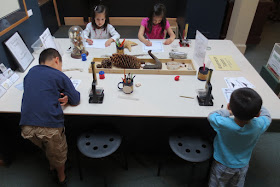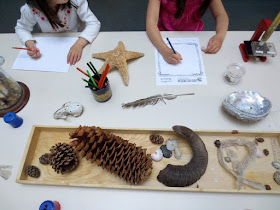We decided to stop in at the Santa Cruz Museum of Natural History, and boy, am I glad we did! It's a very small kid-friendly, hands-on museum, with lots for nature-lovers to see and do. Touch pools with intertidal creatures, stuffed birds, preserved nests, drawers and drawers of seashells, Ohlone artifacts, birdsong stations, a glass-enclosed beehive, and more.
When we first got there, it was packed with two classes of first graders on a field trip. But after an hour, they left, and we headed back in to have the whole place to ourselves. (Love homeschooling.)
But my favorite part was the current exhibition, called The Art of Nature.
The museum walls were lined with journal pages, sketchbooks, and more formal nature prints from local naturalists and scientific illustrators. (I hope you'll pardon the quality of my photos--most of the examples were behind glass. My pictures don't do justice to how lovely these were in person!) As you can imagine, it was wonderful to look through these professional examples, which were mostly done in watercolor, colored pencil, or graphite (media that we too work with in our nature drawing!).
My personal favorite was the one below, by Jenny Keller, a CSU Monterey professor and scientific illustrator:
You can see her in action here, as well as read her thoughts on the importance of sketching for scientists:
"The fact is, scientific illustrations can achieve certain things that a photograph cannot," writes scientific illustrator Jenny Keller. "A good illustration can portray difficult-to-photograph or rarely witnessed events."
"Sketches created while in the field can also record valuable information -- sometimes even more reliably than photography," Keller writes. "Although cameras are indispensable for capturing fleeting events and complex detail (and I would not go into the field without one), they cannot do everything. Colors in photographs are typically (sometimes dramatically) inaccurate, proportions are often distorted, and key features of the species may not be recorded clearly (or captured at all)."
Interesting thoughts about the place of nature drawing in an education, even in a high-tech world--particularly drawing in the field. This isn't something I do often because it's just not practical for me in this season of my life, but it's definitely the ideal.
In honor of the exhibit, they had a table set out for children to try their own nature illustrations. This might have been something new for other kids, but I'm happy to say my CM-educated children felt quite at home! LOL
And I have to say that I felt quite at home too--just look at that lovely TRAY! I think the museum curators must be reading our blog! ;)
As you can imagine, it has sparked lots of nature journaling here at our house. Don't you find it inspiring to look at the work of artists? And the museum works with local universities to offer nature illustration courses--if only we were more local. For now, I'll be content working at the kitchen table with my kids...and really there's no place I'd rather be!
As you can imagine, it has sparked lots of nature journaling here at our house. Don't you find it inspiring to look at the work of artists? And the museum works with local universities to offer nature illustration courses--if only we were more local. For now, I'll be content working at the kitchen table with my kids...and really there's no place I'd rather be!

















I love this entry and we live close enough to Santa Cruz to make a visit the next time we are in that area. Thanks for sharing your entry with the CM Carnival.
ReplyDeleteWow!!!! What an inspiration for nature study and nature notebooks! Thank you for sharing!
ReplyDelete